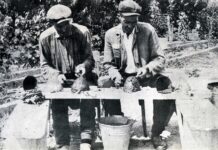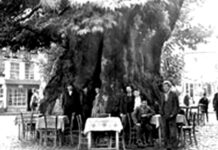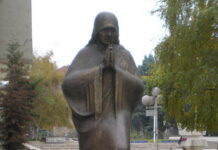At the northern foot of the hill the rivers Brazda and Gluška (Čučerska) meet. These waters were captivated in roman times and supplied the ancient city Skupi and medieval Skopje with drinking water.
The remains of a fortified early antique settlement (5th-4th century B.C. ) can be found on the southern and western slope of the flattened top of Gradište hill, it is deployed in several terraces, on the surface of 4.5 Ha. It was a time when the most northern Paionian tribe Agrians lived in the region, but the type and nature of the excavated ceramic findings triggered a theory that Gradište was populated by Athenians who explored the rich natural resources of the environment.
At the northern foothill in 1986 a monumental structure was found, which according to researchers represents a tomb of a local royalty. This is confirmed primarily by its size, also by the quality of construction and the processing of the blocks, for which the most qualified architects were engaged.

The tomb is dug deep in solid rock, it has a rectangular room or chamber and an entrance with six steps on the south wall.
There is a long access corridor (dromos), which steeply descends the slope of the hill and leads to the entrance. The walls of the chamber are made of nicely shaped travertine stone blocks of different sizes. The estimated weight ranges from 500 to 1500 kg. and it is assumed that they were carried from the stone quarry in the village of Gorno Svilare which is located 23 km from this location.
The blocks are placed on top of each other in horizontal arrays. The front size of each block was relief staged and framed with smooth frame on the edges. Above the entrance of the chamber we can see a horizontal stone-free zone on the north and south wall. A transverse wooden beams which formed the roof of the chamber were inserted there.

The decorative technique is the mark of the Athenian construction from the 5th and the early 4th century BC.
These elements clearly differ from the characteristics of the Hellenistic period that came afterwards. The upper mentioned features, crucial for dating of the tomb have also been confirmed by the pottery findings. The tomb in Brazda had a flat wooden ceiling. Tombs built entirely or partially out of wood are simpler and older than the ones built out of stone and they can be found throughout the 6th – 4th century BC across the vast Euro-Asian space as far the southern influences left a mark..
The tombs of the Macedonian type, from the late 4th and 3rd century BC, with vaulted stone arches, are similar to the Thracian tombs. The tomb from Tetovo was also vaulted, it is very similar to ours and built from travertine blocks in the same way, only much smaller (5,31 x 3, 51 x 1, 85) and with walls with smooth surface. The dating remains open. Judging from the manner of construction, the tomb probably was built in the 4th century BC, but the bronze statue of famous Menada, found in the tomb, confuses. It is made in the late 4th century.
The tomb from Brazda differs from the tombs of the Macedonian type, we can clearly see it the basis : there is no ante chamber and the main chamber is placed transverse to the dromos. The deceased is not laid in the tomb and the embankment on the top didn’t form a mound (tumulus), but it was merged with the environment. Also the stone shields are not known to the Macedonian region. We have analogies in the distant north in the Black Sea area in the royal Scythian tombs in Soloha and in Pazirik in the Altai. The form of this shield is common in Egypt.
The origins of the upper mentioned elements and the paths from which they reached us remain unclear
The fate of the tomb owner also remains vague. According to the situation revealed by excavation we can conclude the following: – After the funeral rituals the chamber door was locked from the outside (with 2 large plates) and the door and the dromos were filled with yellow-brown clay, in which cremated victims were buried occasionally and broken pottery was thrown inside .
It seems that shortly after the funeral, thieves penetrated from the top, broke the door and entered the chamber. Since they didn’t find the deceased here, they dug the whole paved floor. They dug to a depth of 1.2 m below the floor and broke the excavated blocks and threw them aside. That led to the creation of a 2 m high embankment in the chamber above the floor.
The fire that was burning on the both sides of the door damaged the internal doorposts. The destruction was also accelerated by the water (rain water) which penetrated through the hole in the chamber. Several blocks from the top were pushed into the chamber and the two stone shields were among them.
In addition to this conclusion – that the deceased was not resting in the chamber – we can add the fact that not one piece was found from a possible sarcophagus (out of stone) or its base. Similar to many other older tombs, the chamber in Brazda had undoubtedly a commemorative character, while the deceased was buried somewhere beside her.

![Brazda_005[1]](https://diduknow.online/wp-content/uploads/2023/10/Brazda_0051.jpg)




